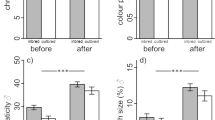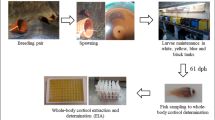Abstract
Groups of juvenile tench (7.02 ± 0.28 g) were reared under four different light regimes; blue light, red light (80 Wm−2 12L:12D photoperiod) white light (912 ± 210 lux, 80 Wm−2, 12L:12D photoperiod) and no light (0 lux) (0L:24D). Visibility of fish out of shelters was used as an indicator of activity and was monitored by video recording. Blood plasma cortisol concentrations were also measured. Fish under blue or white light were significantly less active during the photophase than those under red or no light (P < 0.01). Red light produced similar activity patterns to fish receiving 24 h darkness. Plasma cortisol concentrations were also significantly influenced (P < 0.05) with the fish under white light having the highest plasma cortisol concentration (317 ± 62 ng cm−3) compared to fish in the dark treatment (106 ± 36 ng cm−3). Thus, the provision of coloured light filters increases activity in juvenile tench and may reduce their intrinsic stress level.



Similar content being viewed by others
References
Alanara A, Brannas E (1996) Dominance in demand-feeding behaviour in Arctic charr and rainbow trout: the effect of stocking density. J Fish Biol 48:242–254
Almazan-Rueda P, van Helmond ATM, Verreth JAJ, Schrama JW (2005) Photoperiod affects growth, behaviour and stress variables in Clarias gariepinus. J Fish Biol 67:1029–1039
Appelbaum S, Kamler E (2000) Survival, growth, metabolism and behaviour of Clarias gariepinus (Burchell 1822) early stages under different light conditions. Aquac Eng 22:269–287
Backiel T (1986) Masking effects of variability of growth on its estimation in juvenile tench, Tinca tinca (L.), reared at different temperatures. Pol Arch Hydrobiol 33:69–95
Biswas AK, Takeuchi T (2003) Effects of photoperiod and feeding interval on food intake and growth rate of Nile tilapia (Oreochromis niloticus L.). Fish Sci 69:1010–1016
Biswas AK, Morita T, Yoshizaki G, Maita M, Takeuchi T (2005a) Control of reproduction in Nile tilapia Oreochromis niloticus (L.) by photoperiod manipulation. Aquaculture 243:229–239
Biswas AK, Seoka M, Inoue Y, Takii K, Kumai H (2005b) Photoperiod influences the growth, food intake, feed efficiency and digestibility of red sea bream (Pagrus major). Aquaculture 250:666–673
Boeuf G, Le Bail PY (1999) Does light have an influence on fish growth? Aquaculture 177:129–152
Bowmaker JK (1990) Retinal structure of fishes. In: Douglas RH, Djamgoz MBA (eds) The visual system of fish. Chapman and Hall, London
Britz PJ, Pienaar AG (1992) Laboratory experiments on the effect of light and cover on the behavior and growth of African catfish, Clarias gariepinus (Pisces, Clariidae). J Zool 227:43–62
Ellis T, North B, Scott AP, Bromage NR, Porter M, Gadd D (2002) The relationships between stocking density and welfare in farmed rainbow trout. J Fish Biol 61:493–531
Gallardo JM, Garcia JCE, Ceballos-Zuniga EG, Perez J (2006) Selective behaviour of a tench, Tinca tinca (L.), stock in different light-substrate combined conditions. Aquac Int 14:163–170
Herrero MJ, Pascual M, Madrid JA, Sanchez-Vazquez FJ (2005) Demand-feeding rhythms and feeding-entrainment of locomotor activity rhythms in tench (Tinca tinca). Physiol Behav 84:595–605
Jobling M, Baardvik BM (1994) The influence of environmental manipulations on interindividual and intraindividual variation in food acquisition and growth-performance of Arctic charr, Salvelinus-alpinus. J Fish Biol 44:1069–1087
Kadri S, Huntingford FA, Metcalfe NB, Thorpe JE (1996) Social interactions and the distribution of food among one-sea-winter Atlantic salmon (Salmo salar) in a sea-cage. Aquaculture 139:1–10
Kaiser H, Weyl O, Hecht T (1995) Observations on agonistic behaviour of Clarias gariepinus larvae and juveniles under different densities and feeding frequencies in a controlled environment. J Appl Ichthyol 11:25–36
Karakatsouli N, Papoutsoglou SE, Pizzonia G, Tsatsos G, Tsopelakos A, Chadio S, Kalogiannis D, Dalla C, Polissidis A, Papadopoulou-Daifoti Z (2007) Effects of light spectrum on growth and physiological status of gilthead seabream (Sparus aurata) and rainbow trout (Oncorhynchus mykiss) reared under recirculating system conditions. Aquac Eng 36:302–309
King WV, Hooper B, Hillsgrove S, Benton C, Berlinsky DL (2005) The use of clove oil, metomidate, tricaine methanesulphonate and 2-phenoxyethanol for inducing anaesthesia and their effect on the cortisol stress response in black sea bass (Centropristis striata L.). Aquac Res 36:1442–1449
Luchiari AC, Freire FAD, Koskela J, Pirhonen J (2006) Light intensity preference of juvenile pikeperch Sander lucioperca (L.). Aquac Res 37:1572–1577
Maclean A, Metcalfe NB, Mitchell D (2000) Alternative competitive strategies in juvenile Atlantic salmon (Salmo salar): evidence from fin damage. Aquaculture 184:291–302
Oppedal F, Juell JE, Johansson D (2007) Thermo- and photoregulatory swimming behaviour of caged Atlantic salmon: implications for photoperiod management and fish welfare. Aquaculture 265:70–81
Partridge JC, Cummings ME (1998) Adaptation of visual pigments to the aquatic environment. In: Archer SN, Djamgoz MBA, Loew ER, Partridge JC, Vallerga S (eds) Adaptive mechanisms in the ecology of vision. Kulwer, Dordrecht
Pickering AD, Pottinger TG (1989) Stress responses and disease resistance in salmonid fish—effects of chronic elevation of plasma-cortisol. Fish Phys Biochem 7:253–258
Rennert B, Kohlmann K, Hack H (2003) A performance test with five different strains of tench (Tinca tinca L.) under controlled warm water conditions. J Appl Ichthyol 19:161–164
Ruane NM, Carballo EC, Komen J (2002) Increased stocking density influences the acute physiological stress response of common carp Cyprinus carpio (L.). Aquac Res 33:777–784
Sloman KA, Motherwell G, O’Connor KI, Taylor AC (2000) The effect of social stress on the standard metabolic rate (SMR) of brown trout (Salmo trutta). Fish Physiol Biochem 23:49–53
Spekreijse H, Wietsma JJ, Neumeyer C (1989) Induced color-blindness in goldfish—a behavioral and electrophysiological study, Symposium on Fish Vision: A Multidisciplinary Approach to a Model System, Celebrating the Career of Fred Crescitelli, Oristano, Italy. pp 551–562
Steffens W (1995) The tench (Tinca tinca (L.)), a neglected pond fish species. Pol Arch Hydrobiol 42:161–180
Sverdrup KA, Duxbury AC, Duxbury AB (2004) An introduction to the world’s oceans. McGraw-Hill Higher Education, London
Acknowledgments
This research was funded by the EU 6th framework Craft project: Intensive and sustainable culture of the freshwater species tench; acronym ‘Protench’ (contract number 512575). Thanks are also due to Richard Deyes for help with data collection.
Author information
Authors and Affiliations
Corresponding author
Rights and permissions
About this article
Cite this article
Owen, M.A.G., Davies, S.J. & Sloman, K.A. Light colour influences the behaviour and stress physiology of captive tench (Tinca tinca). Rev Fish Biol Fisheries 20, 375–380 (2010). https://doi.org/10.1007/s11160-009-9150-1
Received:
Accepted:
Published:
Issue Date:
DOI: https://doi.org/10.1007/s11160-009-9150-1




